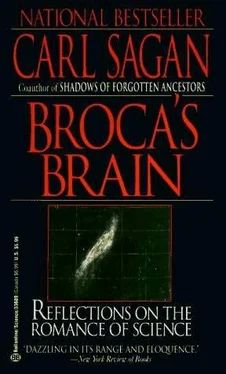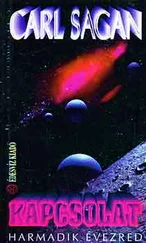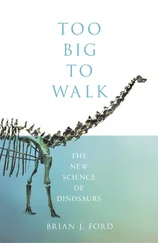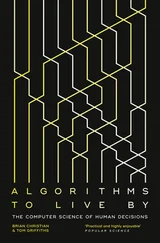Carl Sagan - Broca's Brain - The Romance of Science
Здесь есть возможность читать онлайн «Carl Sagan - Broca's Brain - The Romance of Science» весь текст электронной книги совершенно бесплатно (целиком полную версию без сокращений). В некоторых случаях можно слушать аудио, скачать через торрент в формате fb2 и присутствует краткое содержание. Жанр: Физика, на английском языке. Описание произведения, (предисловие) а так же отзывы посетителей доступны на портале библиотеки ЛибКат.
- Название:Broca's Brain: The Romance of Science
- Автор:
- Жанр:
- Год:неизвестен
- ISBN:нет данных
- Рейтинг книги:3 / 5. Голосов: 1
-
Избранное:Добавить в избранное
- Отзывы:
-
Ваша оценка:
- 60
- 1
- 2
- 3
- 4
- 5
Broca's Brain: The Romance of Science: краткое содержание, описание и аннотация
Предлагаем к чтению аннотацию, описание, краткое содержание или предисловие (зависит от того, что написал сам автор книги «Broca's Brain: The Romance of Science»). Если вы не нашли необходимую информацию о книге — напишите в комментариях, мы постараемся отыскать её.
Broca's Brain: The Romance of Science — читать онлайн бесплатно полную книгу (весь текст) целиком
Ниже представлен текст книги, разбитый по страницам. Система сохранения места последней прочитанной страницы, позволяет с удобством читать онлайн бесплатно книгу «Broca's Brain: The Romance of Science», без необходимости каждый раз заново искать на чём Вы остановились. Поставьте закладку, и сможете в любой момент перейти на страницу, на которой закончили чтение.
Интервал:
Закладка:
INTERROGATOR: How about “a Winter’s day”? That would scan all right.
WITNESS: Yes, but nobody wants to be compared to a Winter’s day.
INTERROGATOR: Would you say Mr. Pickwick reminded you of Christmas?
WITNESS: In a way.
INTERROGATOR: Yet Christmas is a Winter’s day, and I do not think Mr. Pickwick would mind the comparison.
WITNESS: I don’t think you’re serious. By a Winter’s day one means a typical Winter’s day, rather than a special one like Christmas.
No device of this sophistication has yet been built, although I am not sure how many humans would pass Turing’s human test. But the amount of effort and money put into artificial intelligence has been quite limited, and there are only about a half-dozen major centers of such activity in the world. One of the more striking results obtained in a very limited universe of discourse-that of children’s blocks-has come from the work of Terry Winograd, then at the Massachusetts Institute of Technology. Here is a dialogue between man and machine, the machine having been programmed by Winograd:
Q: What does the box contain?
A: The blue pyramid and the blue box.
Q: How many blocks are not in the box?
A: Four of them.
Q: Is at least one of them narrower than the one which I told you to pick up?
A: Yes, the red cube.
Q: Is there a steeple?
A: Sorry, I don’t know the word “steeple.”
Q: A steeple is a stack which contains two green cubes and a pyramid, for example.
A: I understand.
Q: Are there any steeples now?
A: No.
Q: Build one.
The machine does. It reaches out its mechanical hand, moves the cubes and builds the structure that has just been described.
Q: When did you pick up the pyramid?
A: While I was stacking up the red cube, the large red block and the large green cube.
Q: Why?
A: To get rid of it.
Q: Why did you clear off that cube?
A: To put it on the large green cube.
As another example, a machine psychiatrist has been developed by Joseph Weizenbaum, also at MIT. This is a much simpler program than Winograd’s, since it involves nondirective psychotherapy, which, generally speaking, requires extremely simple-minded computer programs. Here is a striking dialogue between a human being and a computer psychotherapist (There is certainly a selection effect here. Many other such machine/human psychiatric dialogues are not nearly so striking. But I suppose most human/human psychiatric dialogues are not very striking either.) In this interaction, in order to spell out clearly the respective roles of therapist and patient, the computer therapist types upper case while the patient types lower case:
men are all alike
IN WHAT WAY
they’re always bugging us about something or other
CAN YOU THINK OF A SPECIFIC EXAMPLE
well, my boy friend made me come here
YOUR BOY FRIEND MADE YOU COME HERE
he noticed that i’m depressed much of the time
I AM SORRY TO HEAR YOU ARE DEPRESSED
he’s right. I am unhappy
DO YOU THINK COMING HERE WILL HELP YOU NOT TO BE UNHAPPY
i need some help, that much is clear
WHAT WOULD IT MEAN TO YOU IF YOU GOT SOME HELP
perhaps i could learn to get along with my mother
TELL ME MORE ABOUT YOUR FAMILY
my mother takes care of me
WHO ELSE IN YOUR FAMILY TAKES CARE OF YOU
my father
YOUR FATHER
you are like my father in some ways
WHAT RESEMBLANCE DO YOU SEE
you are not very aggressive, but i don’t think you want me to notice that
WHAT MAKES YOU THINK I AM NOT VERY AGGRESSIVE
you don’t argue with me
WHY DO YOU THINK I DON’T ARGUE WITH YOU
you are afraid of me
DOES IT PLEASE YOU TO BELIEVE I AM AFRAID OF YOU
it pleases my father to think i am afraid of him
WHAT ELSE COMES TO MIND WHEN YOU THINK OF YOUR FATHER
bullies
DOES THAT HAVE ANYTHING TO DO WITH THE FACT THAT YOUR BOY FRIEND MADE YOU COME HERE
This astonishing-one is very tempted to say “perceptive”-response from the computer is, of course, preprogrammed. But, then, so are the responses of human psychotherapists. In a time when more and more people in our society seem to be in need of psychiatric counseling, and when time-sharing of computers is widespread, I can even imagine the development of a network of computer psychotherapeutic terminals, something like arrays of large telephone booths, in which, for a few dollars a session, we are able to talk to an attentive, tested and largely nondirective psychotherapist. Ensuring the confidentiality of the psychiatric dialogue is one of several important steps still to be worked out.
ANOTHER SIGN of the intellectual accomplishments of machines is in games. Even exceptionally simple computers-those that can be wired by a bright ten-year-old-can be programmed to play perfect tic-tac-toe. Some computers can play world-class checkers. Chess is of course a much more complicated game than tic-tac-toe or checkers. Here programming a machine to win is more difficult, and novel strategies have been used, including several rather successful attempts to have a computer learn from its own experience in playing previous chess games. Computers can learn, for example, empirically the rule that it is better in the beginning game to control the center of the chessboard than the periphery. The ten best chess players in the world still have nothing to fear from any present computer. But the situation is changing. Recently a computer for the first time did well enough to enter the Minnesota State Chess Open. This may be the first time that a non-human has entered a major sporting event on the planet Earth (and I cannot help but wonder if robot golfers and designated hitters may be attempted sometime in the next decade, to say nothing of dolphins in free-style competition). The computer did not win the Chess Open, but this is the first time one has done well enough to enter such a competition. Chess-playing computers are improving extremely rapidly.
I have heard machines demeaned (often with a just audible sigh of relief) for the fact that chess is an area where human beings are still superior. This reminds me very much of the old joke in which a stranger remarks with wonder on the accomplishments of a checker-playing dog. The dog’s owner replies, “Oh, it’s not all that remarkable. He loses two games out of three.” A machine that plays chess in the middle range of human expertise is a very capable machine; even if there are thousands of better human chess players, there are millions who are worse. To play chess requires strategy, foresight, analytical powers, and the ability to cross-correlate large numbers of variables and to learn from experience. These are excellent qualities in those whose job it is to discover and explore, as well as those who watch the baby and walk the dog.
With this as a more or less representative set of examples of the state of development of machine intelligence, I think it is clear that a major effort over the next decade could produce much more sophisticated examples. This is also the opinion of most of the workers in machine intelligence.
In thinking about this next generation of machine intelligence, it is important to distinguish between self-controlled and remotely controlled robots. A self-controlled robot has its intelligence within it; a remotely controlled robot has its intelligence at some other place, and its successful operation depends upon close communication between its central computer and itself. There are, of course, intermediate cases where the machine may be partly self-activated and partly remotely controlled. It is this mix of remote and in situ control that seems to offer the highest efficiency for the near future.
For example, we can imagine a machine designed for the mining of the ocean floor. There are enormous quantities of manganese nodules littering the abyssal depths. They were once thought to have been produced by meteorite infall on Earth, but are now believed to be formed occasionally in vast manganese fountains produced by the internal tectonic activity of the Earth. Many other scarce and industrially valuable minerals are likewise to be found on the deep ocean bottom. We have the capability today to design devices that systematically swim over or crawl upon the ocean floor; that are able to perform spectrometric and other chemical examinations of the surface material; that can automatically radio back to ship or land all findings; and that can mark the locales of especially valuable deposits-for example, by low-frequency radio-homing devices. The radio beacon will then direct great mining machines to the appropriate locales. The present state of the art in deep-sea submersibles and in spacecraft environmental sensors is clearly compatible with the development of such devices. Similar remarks can be made for off-shore oil drilling, for coal and other subterranean mineral mining, and so on. The likely economic returns from such devices would pay not only for their development, but for the entire space program many times over.
Читать дальшеИнтервал:
Закладка:
Похожие книги на «Broca's Brain: The Romance of Science»
Представляем Вашему вниманию похожие книги на «Broca's Brain: The Romance of Science» списком для выбора. Мы отобрали схожую по названию и смыслу литературу в надежде предоставить читателям больше вариантов отыскать новые, интересные, ещё непрочитанные произведения.
Обсуждение, отзывы о книге «Broca's Brain: The Romance of Science» и просто собственные мнения читателей. Оставьте ваши комментарии, напишите, что Вы думаете о произведении, его смысле или главных героях. Укажите что конкретно понравилось, а что нет, и почему Вы так считаете.











